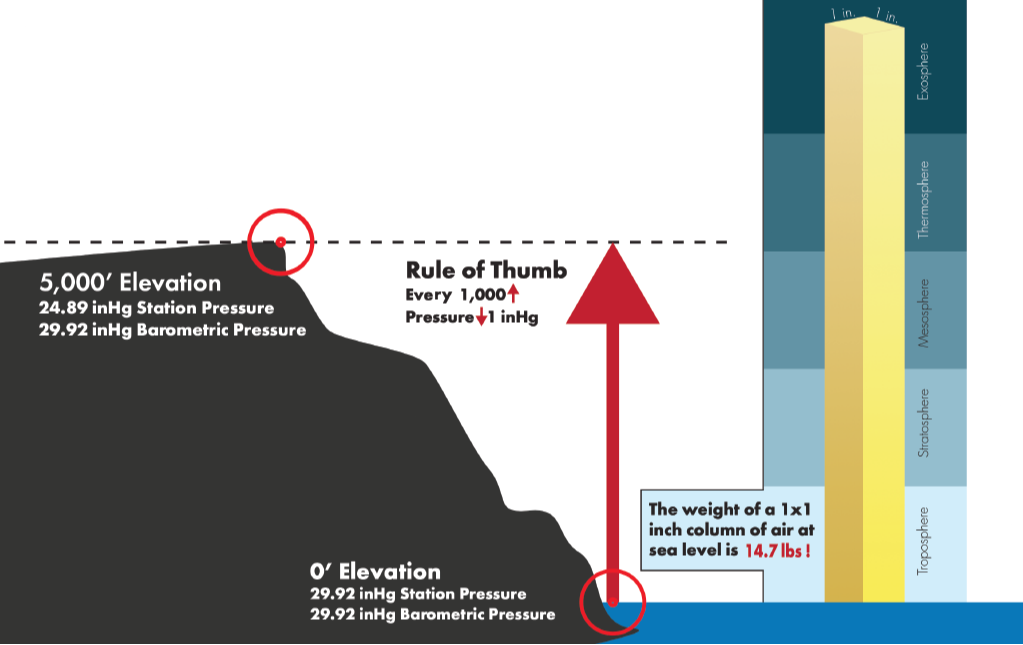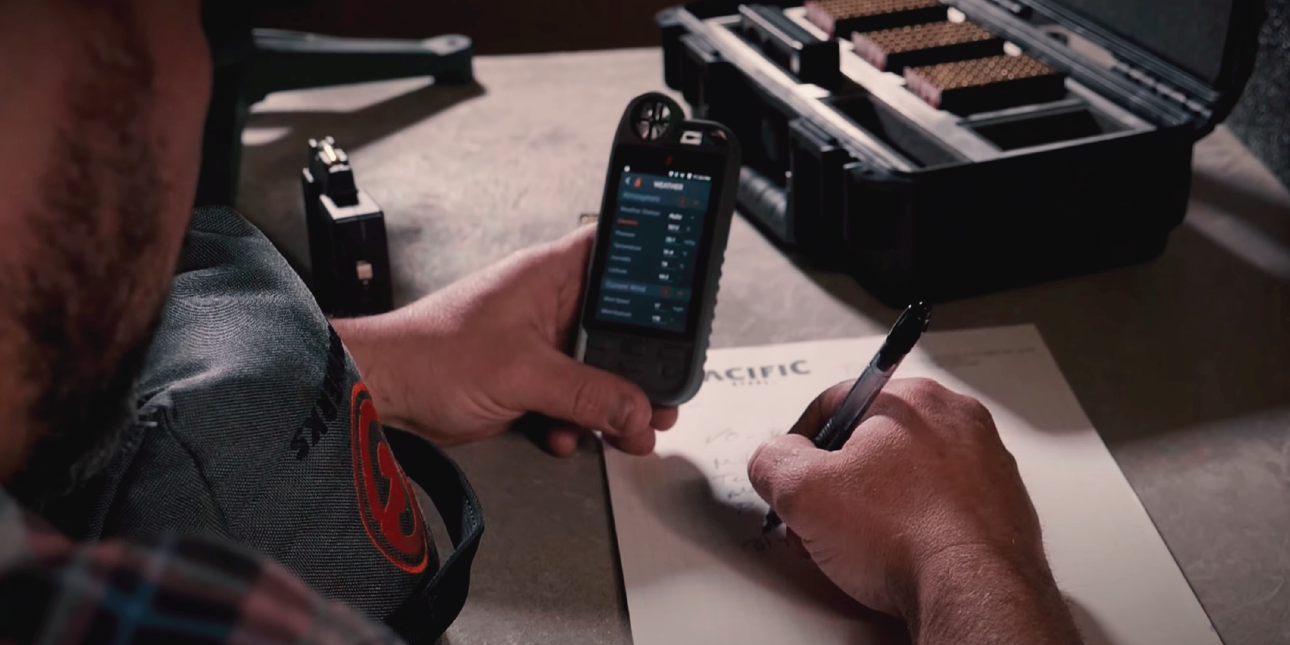Temperature and Altitude are related in that they both affect air density and therefore the ballistic performance of a bullet. Lower altitudes and lower temperatures result in denser air, therefore more drag on the bullet and more bullet drop. Conversely, higher altitudes and higher temperatures result in thinner air, therefore less drag on the bullet and less bullet drop. When bullet manufacturers test their bullets, to ensure they are comparing apples to apples they use a standard which has been adopted across the industry at: Sea level; 78% humidity; 59 degrees Fahrenheit; and Barometric Pressure of 29.92.
Here we present rules of thumb in “percentage change of bullet drop” and therefore percentage change in the required elevation on your scope. The reason for this, is a percentage change translates to different yardages where as a rule which stated a certain number of minutes of angle would only be true for one yardage. At 300 yards a 10% change in bullet drop for the particular cartridge I’m using is the equivalent of a 1/3rd MOA or just over 1 inch. At 800 yards a 10% change is 1.6 MOA or approximately 13 inches. Is it worth considering at 300 yards? Probably not, but it is definitely a factor at 800 yards. Is a 1% change worth considering? That depends on your cartridge and how far you are shooting. One percent of 17 minutes of drop (800 yards) is not very significant, but 1% of 57 minutes of drop (1600 yards) is more significant.
Humidity
Humidity does play a role in long range ballistics; however the effect is so minimal we can generally disregard it. In a nutshell humid air has slightly less density than dry air so humid air has slightly less drag on a bullet. As I write this, the closest weather station shows 53% humidity in the Revic Ballistic App. A .284 caliber 180 grain Berger VLD bullet at 2,750 fps takes 17.7 MOA of elevation to get point of aim/point of impact at 800 yards. If I manually change the humidity to 5%, it takes 17.8 MOA. Considering your scope likely has 0.25 MOA adjustments, the error here is too small to adjust for.
Altitude
Using the same bullet velocity combination, if I manually enter an altitude of sea level I get 16.9 MOA elevation required for 800 yards. If I manually enter 10,000 feet I get 15.5 MOA. If I divide 16.9 by 15.5 I learn that the 10,000 foot change in elevation has caused a 9% change in bullet drop. Although not exactly correct a good rule of thumb is 1000 ft change in elevation equals a 1% change in bullet drop. Higher altitudes will require less elevation in our scope and lower altitudes will require more elevation.

Daily Changes in Barometric Pressure
High pressure systems and low pressure systems cause daily changes of the barometric pressure. High pressure systems usually bring clear sunny weather and low pressure systems usually bring stormy weather. Average air pressure at sea level is 29.92 inches of mercury. Pressures rarely change more than an inch above or below this average unless there is a very severe storm. A change of one inch is the approximate equivalent of a 1000 foot change in altitude. In the preceding paragraph we learned that 1000 feet equals slightly less than a 1% change in the scope turret elevation required for a long range shot. For the most part we can ignore daily fluctuations in the weather and the corresponding air pressure.
Temperature
Temperature is more complex because it gets us in two different ways. First it affects air density. Colder air is denser (more drag) and warmer air is thinner (less drag). Temperature also affects the burn rate of most gun powders with the exception of the Hodgdon Extreme line and perhaps some other newer powders designed to be temperature stable. In these modern temperature stable powders, the effect of temperature on burn rates, and therefore muzzle velocity, is greatly reduced. Hotter temperatures equal a faster burn rate and more velocity. Colder temperatures equal a slower burn rate and lower velocity. The velocity variance differs between different powders; however it ranges from less than 1 foot per second per degree to as much as 2 feet per second per degree.
We will address the air density first. If I input a zero degree Fahrenheit temperature into the Revic App it gives me 16.3 MOA at 800 yards. If I change the temperature to 100 degrees it gives me 15.6 MOA. This is a change of slightly less than 5% so a 20 degree change in temperature equals about a 1% change in bullet drop. Keep in mind this does not take any resulting velocity change into account.
In the Revic App under the Profiles you have the option to input the temperature at which the muzzle velocity was measured, (Powder Temperature) and the fps per degree change. (Powder Factor). I input 50 degrees and 1 fps per degree which I believe is pretty accurate for the IMR 7828 powder I use in this particular .280 Ackley Improved load.
Now when I enter a temperature of 0 degrees Fahrenheit in the ballistic calculator it shows I need 17 MOA of elevation on my scope for 800 yards. Remember in the previous paragraph when I did not take the velocity change into account, only the air density, the required elevation was 16.3 MOA. Now if I change the temperature to 100 degrees Fahrenheit I only need 15 MOA of elevation. The combined effect of air density and velocity change is 12% over a 100 degree temperature span. Rounded off this is 1% for every 10 degree change.
If I repeat the last process but input 2 fps per degree of temperature change, a number I have seen with Reloader 22 powder, the numbers are 17.7 MOA at 0 degrees, and 14.4 MOA at 100 degrees. This is a 20% change which is huge, 1% for every 5 degrees.
Rule of thumb if you are using non temperature stable powders, is a 1% change in bullet drop for every 10 degrees… maybe 5 degrees depending on the powder. If you are using temperature stable powders then the effect of temperature is approximately 1% per 20 degrees.

How do I manage all this?
The good news here is that the combined effects of temperature and altitude can all be measured and calculated precisely in a ballistic program. You can make do with the Revic App on a smart phone so long as you are connected to a local weather station or you manually enter the atmospherics correctly. Life is much easier if you have a Revic enabled system with an on board weather station. Then the potential for operator induced error is much less. Even the factors which have very minor effects, such as humidity will be figured into the solution.
Luckily, we have modern technology that handles all the measurement and compensation for us, but to be true marksmen, it’s important to understand the underlying mechanisms and the ability to apply this knowledge manually. I believe in having multiple methods at my disposal to arrive at the correct solution so if one piece of equipment fails due to a dead battery, or my cold fingers can’t work a touchscreen, I have a backup method.
The Effects Of Temperature and Altitude In Long Range Shooting